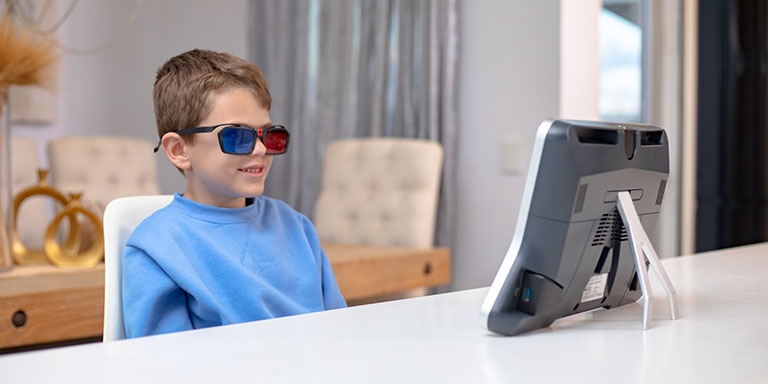Good vision is critical for children’s development, which makes early diagnosis and treatment of eye-related problems important. But eye specialists are familiar with issues associated with testing young children’s vision as the charts can be hard to understand, especially for toddlers.
A common problem with children’s vision is amblyopia, where a dominant eye gradually eclipses its counterpart, hence the more common term “lazy eye”. For centuries this has been treated with an eyepatch over the dominant eye, forcing the “lazy” one to work harder. But, understandably, many children are reluctant to wear an eyepatch all day – especially since it makes them stand out in the playground.
Sharp vision
Israel-based start-up NovaSight is tackling this issue through its self-developed sophisticated algorithms that can diagnose common vision problems among children and treat amblyopia.
Since the system is cloud-based, it can easily be deployed anywhere in the world. Setting its sights on overseas markets, NovaSight recently announced that the first patients in its clinical trial of the CureSight™ amblyopia treatment in Mainland China has been successfully enrolled.
“The study, which includes two sites in Shanghai, is led by Dr Rui Liu from the Eye & ENT Hospital of Fudan University, one of the mainland's top hospitals, and will involve 20 patients in the CureSight treatment group and 20 in the patching control group,” a NovaSight statement said.

“This marks another milestone for NovaSight and the beginning of our journey to secure the mainland National Medical Products Administration clearance in preparation for our future commercial activities in the mainland.”
Ran Yam, CEO of NovaSight, said results of the Shanghai study would be released by the end of 2022.
A similar earlier study in Israel showed that NovaSight’s CureSight system was non inferior to the traditional eyepatch.
Analysis of the results also showed that best corrected visual acuity (BCVA) improvement at week 16 was larger in the treatment group compared to the patching control group, Mr Yam said.
“Moreover, a significant stereo acuity improvement was observed in both groups. Lastly, no serious adverse events were observed in either treatment arms (CureSight or patching) and all non-serious adverse events were transient and self-limiting.”
He said patient compliance with the CureSight system was strong.
“The study also evaluated adherence and patient satisfaction. The mean adherence to CureSight use during the study among subjects evaluated at the week 16 visit (43 subjects) was 93%, as measured by the CureSight’s eye tracking system. In addition, 95% of parents reported that they are likely or very likely to choose the CureSight digital treatment over patching.”
Stereoscopic solution

Mr Yam said CureSight trains the visual system to use both eyes simultaneously, with the user watching his favourite streamed video content at the comfort of home, through red-blue treatment glasses. The system tracks the user’s eye movements. Algorithms then blur out parts of the image viewed by the dominant eye, forcing the weaker eye to complete the image (main picture). Since both eyes are open, this improves stereoscopic vision.
He said NovaSight was also planning to introduce its EyeSwift®PRO system, which helps diagnose conditions such as myopia by tracking patients’ eye movements as they watch animated videos on a screen.
“Traditional vision exams such as the eye chart, undergone by hundreds of millions of patients worldwide every year, are manual, subjective, time-consuming, limited and often inaccurate – especially for toddlers who can’t always understand the examiner’s instructions or communicate what they’re seeing,” Mr Yam said. “Therefore, they are not sufficiently effective to detect many visual impairments, including amblyopia (lazy eye). As a result, these conditions often go undetected or are misdiagnosed.
“The EyeSwift®PRO, the second-generation to the EyeSwift device, is designed to replace the traditional eye chart and other manual exams and deliver any trained eye-care provider various fields of diagnostic tools by using dedicated protocols such as myopia, amblyopia, binocular vision and more.”
He added that the system can be suitable for adults as well as children.
Raising horizons
Noting the sharp rise in myopia (short sightedness) among children worldwide in the 21st century, brought about by longer time spent indoors and heavy screen use, Mr Yam said NovaSight was working on this problem.
“Though screen usage in the digital age is impossible to avoid, it is important to acknowledge and minimise the eye-health risks associated with prolonged screen time. Unfortunately, today’s laptops and tablets do not offer objective and efficient tools to minimise the myopic effect.
“To accommodate this unmet need, NovaSight is developing TrackSight™, a software as a service (SaaS) solution for myopia prevention and visual health monitoring running on laptops and tablets used by children for both educational and leisure purposes.”
Related link
NovaSight


